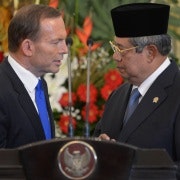How 'modern' can Labor go on unions?
One of the challenges Bill Shorten faces as Labor leader is how he and the ALP deal with the perception, and reality, of excessive union influence on the party.
This is a problem at multiple levels. Only a fraction of the modern workforce is unionised, but the structure of the ALP gives unions a big say. The ranks of Labor MPs are crowded with former union officials, with too few people drawn more widely from the community.
Shorten himself, as a former national secretary of the Australian Workers' Union, is strongly identified with the trade union movement.
With recent examples of union corruption fresh in people’s minds and now a royal commission investigating it, the union link will be a particularly difficult issue for Labor to handle.
This was obvious when the Abbott government mooted the royal commission. The opposition opposed it (and says it hasn’t changed that position) but now that the commission is a fait accompli Shorten emphasises that Labor will fully cooperate.
Appearing at the National Press Club on Wednesday, Shorten indicated he is giving thought to the union-party issue. He used the same term in answer to two questions about party reform: Labor had to “modernise” its relationship with the unions. “Let there be no one under any doubt. I think we have to,” he said. He promised he’d have more to say in coming weeks and months.
He’s opening an issue that’s recently been debated in Britain, with the Labour party there making changes to the links between the party and the unions.
Shorten’s context is the need to broaden the appeal of Labor, electorally and in terms of recruiting members. “In 2014 Labor has 44,000 members. We should have 100,000. To deliver Labor’s vision for a modern Australia, we must reach out to new constituencies to represent the diversity of modern Australia,” he said.
“We need to appeal to people who traditionally have not seen themselves as spoken to by the Labor party. We do need to make sure that people are a member of the Labor Party first, not a member of a faction first,” he said.
“And I think that we have an opportunity to really make the Labor Party as confident, as broad-based, as democratic and as outward-looking as we want this nation to be, but we do have to do it.”
Shorten’s comments mix his desire for Labor to pitch to a wider range of voters with an implicit recognition that factionalism and the high profile of the unions in the party work against that.
It would be a major step, however, for Shorten to actually embark on reform that threatens the unions' power in the ALP.
Some Labor hardheads question whether the effort would be worth it. The historical evidence is mixed. For Gough Whitlam, party reform, which included taking on a powerful union clique in Victoria, was a crucial step on his way to winning office. He changed both the power balances within the party and the image that voters had of it.
With Simon Crean it was another story. He succeeded in reducing the union representation at the ALP national conference (which comes indirectly via state conferences) from 60-40 to 50-50, but it was a bruising battle that weakened his leadership.
For a leader, achieving a marginal reduction in union representation can be as easily portrayed as a loss as it can a victory. And the unions would fight tooth and nail against any real lessening in their clout.
On the other hand, there is a push in the party for more democratisation, which gained momentum after the rank and file got a say in choosing the federal leader (Shorten says this process should be extended to choosing state leaders).
A report on the 2010 election by Senator John Faulkner and former premiers Steve Bracks and Bob Carr recommended that party members should directly elect a component of the party’s national conference. This was endorsed in principle but then disappeared into a committee for details to be worked out.
Shorten will at least need to deliver on this reform if he is to have any credibility on the question of promoting democracy within the party.
But the change would almost certainly be more cosmetic than real. For one thing, the power of the national conference is diminished compared with a few decades ago. For another, while the unions retain their hold at state level, feeding into the factional power play of pre-selections – in which Shorten has been a leading participant – their grip will be hard to break.
Michelle Grattan does not work for, consult to, own shares in or receive funding from any company or organisation that would benefit from this article, and has no relevant affiliations.
This article was originally published on The Conversation. Read the original article.













